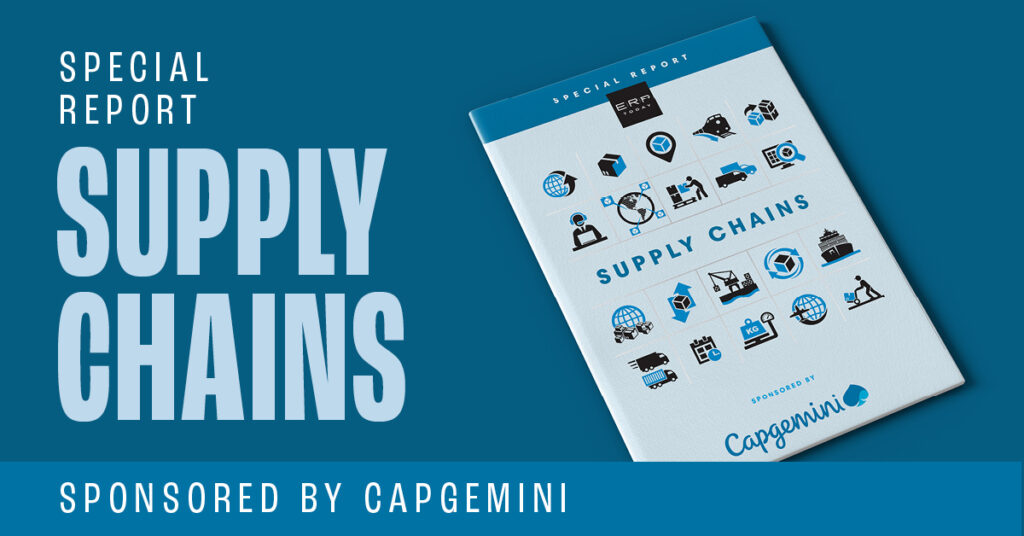It wasn’t so long ago that terms such as ‘supply chain’ and ‘product shortages’ were never really mentioned in daily news bulletins. Since the pandemic though, it’s almost become a daily occurrence, the latest problem being disruption to food supplies thanks to Russia’s attack on Ukraine. Global supply chains have never been so fragile.
The situation is so dire, in fact, that it recently led Verity Davidge, director of policy at
Make UK, to suggest the era of globalisation is “passing its peak,” adding that disruption and volatility for global trade is fast becoming normal. “For many companies this will mean leaving ‘just in time’ behind and embracing ‘just in case’,” she says, referring to the manufacturing mantra of the past three decades.
However, with the rules of supply chains being redrawn, what does the current situation actually mean for the workforce? Are supply chain functions also changing, and are there enough skilled workers to go around? Or should organisations be looking more towards data-driven automation, to not just deal with skills shortages but also optimise existing supply chain operations?
We are clearly in a transition, but the pandemic has illustrated the need for urgency. Resiliency is now the watchword amongst business, but the problem is that no matter where you look, there seems to be a severe shortage of skills. This is both undermining any attempts at transformation and the ability of supply chains to deal with disruptions. The big problem is that we are in a perfect storm of change with the so-called ‘grey resignation’, whereby baby boomers are reaching retirement age at a point when global supply chain issues are starting to bite.
“There are 72,000 fewer HGV drivers in 2021, compared to 2019,” says Philip van der Wilt, VP EMEA at IoT and fleet management company
Samsara. “Warehousing operatives, back-office staff and other critical roles within the supply chain are also in decline.
“Making matters worse is companies relying on employees to put in overtime to make up for it, leading to increased stress and burnout. In fact, company demands for extra time are one of the biggest factors that contribute to employees quitting.”
It’s a situation ripe for change. According to Emile Naus, partner at independent management consulting firm
BearingPoint, the current business and sociopolitical conditions are forcing a rapid shift in recruitment. Supply chain teams will need to evolve quickly and embrace a diverse blend of skills and people.
The future workforce needs to consider different ways of solving problems / Emile Naus

“Employees need to have a mixture of supply chain, industry, data and analytics hard skills, combined with the soft skills to be able to implement the changes across functional areas,” says Naus. “The future workforce will need to be able to consider different ways of solving problems, taking a balanced view across costs, service, risk and environmental impacts. It will be more important than ever to build diverse teams that can consider all these elements and balance them appropriately.”
The problem for supply chain management is that this pretty much reflects the recruitment descriptions for so many other departments and industries. In theory the potential pool of talent is widened, but that also means increased competition. Nevertheless, Naus suggests it’s imperative that organisations spread their recruitment nets wider, adding that they need to be looking at top tech universities for graduates, balanced against experienced supply chain operators, and financial knowledge skills measured against environmental engineering skills.
It’s the kind of scenario painted by Dan Bieler, principal analyst at
Forrester in a recent blog, one relevant to many industries. In it, Bieler writes that “European governments, businesses, and societies need to prepare for a fundamental transformation of their skills base to survive and thrive.
“To drive sustainable growth and innovation and to prepare for the future of work, European businesses depend on a blend of digital and technology-related skills as well as critical thinking, problem solving, resilience, active learning, interpersonal, leadership, and communication skills.”
Businesses need to prepare for a fundamental transformation / Dan Bieler

What this means for supply chain management is that to compete for the skills required to get over current disruption humps whilst also building a robust structure for future resiliency, companies will need to up their game. Attracting talent will become one of the biggest challenges of the next 18 months but, as Bieler adds, other factors, such as geography, can also have a significant influence.
As supply chain teams look towards digital transformation and a corresponding increase in the number of data and digital literate employees, where organisations are physically based has a bearing on matters. Across Europe, tech skills clusters have been evolving, mainly around university towns. The worrying sign for UK-based organisations is that, according to Forrester’s report Navigating The Leading Skill Clusters Across Europe, Brexit is having an impact. UK cities are consistently falling down the list of leading tech skill clusters for recruitment.
To a certain extent, remote working can help with this. As Henrik Smedberg, head of intelligent spend management UKI,
SAP says, the future of the supply chain workforce could be more liquid and flexible than ever.
Keeping a talent pool engaged is a challenge many of our customers face / Henrik Smedberg

“We are hearing and seeing trends of hiring in multiple geographies and with more remote work than ever before,” says Smedberg. “This is great from a flexibility perspective for both employees and employers. It allows skills to be accessed from various places, faster, and in variable quantities.
“Getting visibility to the talent and keeping a talent pool engaged is a challenge many of our customers face, but this is where technology is crucial. Building teams and culture remotely is the hardest part, and strategies to maintain and grow culture need to be carefully evaluated with more hybrid workspaces.”
The robots are coming
Smedberg makes a good point. The mindset of work and location is undoubtedly changing. To some degree, remote work could counter the geographical problem, but again that puts any supply chain department or logistics business into the skills bun fight with other industries, and, in theory, other countries.
How organisations attract skills will be key. It’s a seller’s market, as far as skills are concerned, so supply chain organisations will have to re-evaluate their employment packages. Are they attractive enough to compete?
The type and breadth of work is also evolving. One of the building blocks for supply chain resiliency is planning. Increasingly data-driven and analytics based, supply chain planning requires digital literacy but it also demands experience in understanding supply chain challenges. It’s a mix of the old and the new, and this is where employment challenges become even more interesting.
“Organisations need insight into shipping, supply chains and connected enterprises, so that decisions can be made, or changed based on this visibility,” says Smedberg. “Networks can drive this visibility. If you see it early and notice the cracks, then they can be patched. If not seen then, well – that is when you have issues.”
Unsurprisingly perhaps, this is where AI and robotic process automation (RPA) solutions are leaning. As a recent
Gartner report says, emerging and maturing supply chain technologies are a major source of competitive advantage. If supply chain businesses can get the mix right, of technology, supply chain experience and young digitally-driven skills, then they could be onto a good thing.
“We’re seeing many industrial organisations turn to AI to improve the employee experience and overall operations,” says van der Wilt at Samsara. “For example, security cameras can use AI to detect and alert managers to possible security risks, including motion in restricted areas.
Access to real-time data to inform decision making is critical
/ Philip van der Wilt

“
O’Neal Steel is a good example of a company that has positively impacted its workforce by leveraging AI. With a handful of smaller sites that often go unstaffed during the late hours of the night, supervisors used to spend hours every morning passively searching through security camera footage.
“By using AI-powered motion detection alerts, they saw a 92 percent reduction in time spent reviewing footage, saving 100 hours each week. AI helped save a lot of time and frustration and improved their employees’ day-to-day experience overall.”
Interestingly, Gartner makes a number of supply chain technology predictions, one of which is that “by 2026, 75 percent of large enterprises will have adopted some form of intralogistics smart robots in their warehouse operations.” In addition to predictive analytics and IoT, robotics is seen as a key enabler.
As Dwight Klappich, VP analyst at Gartner says, “there are certain developments that drive further investments into technology, most notably labour constraints and the need for more agility.
“Given today’s volatile and disruptive environment, supply chain organisations must become more flexible, and the solution is digitalisation.”
Of course, this doesn’t mean that robots are going to take over all the jobs. Far from it. What it does mean though is that a forward-planning, more resilient supply chain operation will demand a different set of skills. We are already seeing this, as Gartner’s Supply Chain Top 25 list showcases. This features a number of businesses, such as
Cisco and
Colgate-Palmolive that have transformed through the pandemic, recognising the value of digitisation and the role of a digital-savvy workforce. Interestingly, Cisco also topped Fortune Magazine’s Top 100 best places to work in 2021.
So, what is the strategy? Surely supply chains need to plan better, using data to inform real time decision making. How does this affect recruitment and training plans?
“Access to real-time data to inform decision making is critical to overcoming the supply chain skills shortage,” says van der Wilt. “For example, drivers being provided with real-time information, customised routes and digitised documents makes the life of an industrial worker simply better.
“The delays, frustration and bottom-line costs caused by pen and paper, manual unconnected processes and workflows are mind boggling.”
Is this a battle for talent or a race to automation? Ultimately it is both. As van der Wilt concludes, “it’s time for the industrial, blue-collar workers, and their management counterparts to benefit from the same digitised workflows and processes industries such as telecommunications, financial services and retail have experienced for years.”


 “Employees need to have a mixture of supply chain, industry, data and analytics hard skills, combined with the soft skills to be able to implement the changes across functional areas,” says Naus. “The future workforce will need to be able to consider different ways of solving problems, taking a balanced view across costs, service, risk and environmental impacts. It will be more important than ever to build diverse teams that can consider all these elements and balance them appropriately.”
The problem for supply chain management is that this pretty much reflects the recruitment descriptions for so many other departments and industries. In theory the potential pool of talent is widened, but that also means increased competition. Nevertheless, Naus suggests it’s imperative that organisations spread their recruitment nets wider, adding that they need to be looking at top tech universities for graduates, balanced against experienced supply chain operators, and financial knowledge skills measured against environmental engineering skills.
It’s the kind of scenario painted by Dan Bieler, principal analyst at Forrester in a recent blog, one relevant to many industries. In it, Bieler writes that “European governments, businesses, and societies need to prepare for a fundamental transformation of their skills base to survive and thrive.
“Employees need to have a mixture of supply chain, industry, data and analytics hard skills, combined with the soft skills to be able to implement the changes across functional areas,” says Naus. “The future workforce will need to be able to consider different ways of solving problems, taking a balanced view across costs, service, risk and environmental impacts. It will be more important than ever to build diverse teams that can consider all these elements and balance them appropriately.”
The problem for supply chain management is that this pretty much reflects the recruitment descriptions for so many other departments and industries. In theory the potential pool of talent is widened, but that also means increased competition. Nevertheless, Naus suggests it’s imperative that organisations spread their recruitment nets wider, adding that they need to be looking at top tech universities for graduates, balanced against experienced supply chain operators, and financial knowledge skills measured against environmental engineering skills.
It’s the kind of scenario painted by Dan Bieler, principal analyst at Forrester in a recent blog, one relevant to many industries. In it, Bieler writes that “European governments, businesses, and societies need to prepare for a fundamental transformation of their skills base to survive and thrive. What this means for supply chain management is that to compete for the skills required to get over current disruption humps whilst also building a robust structure for future resiliency, companies will need to up their game. Attracting talent will become one of the biggest challenges of the next 18 months but, as Bieler adds, other factors, such as geography, can also have a significant influence.
As supply chain teams look towards digital transformation and a corresponding increase in the number of data and digital literate employees, where organisations are physically based has a bearing on matters. Across Europe, tech skills clusters have been evolving, mainly around university towns. The worrying sign for UK-based organisations is that, according to Forrester’s report Navigating The Leading Skill Clusters Across Europe, Brexit is having an impact. UK cities are consistently falling down the list of leading tech skill clusters for recruitment.
To a certain extent, remote working can help with this. As Henrik Smedberg, head of intelligent spend management UKI, SAP says, the future of the supply chain workforce could be more liquid and flexible than ever.
What this means for supply chain management is that to compete for the skills required to get over current disruption humps whilst also building a robust structure for future resiliency, companies will need to up their game. Attracting talent will become one of the biggest challenges of the next 18 months but, as Bieler adds, other factors, such as geography, can also have a significant influence.
As supply chain teams look towards digital transformation and a corresponding increase in the number of data and digital literate employees, where organisations are physically based has a bearing on matters. Across Europe, tech skills clusters have been evolving, mainly around university towns. The worrying sign for UK-based organisations is that, according to Forrester’s report Navigating The Leading Skill Clusters Across Europe, Brexit is having an impact. UK cities are consistently falling down the list of leading tech skill clusters for recruitment.
To a certain extent, remote working can help with this. As Henrik Smedberg, head of intelligent spend management UKI, SAP says, the future of the supply chain workforce could be more liquid and flexible than ever.
 “We are hearing and seeing trends of hiring in multiple geographies and with more remote work than ever before,” says Smedberg. “This is great from a flexibility perspective for both employees and employers. It allows skills to be accessed from various places, faster, and in variable quantities.
“We are hearing and seeing trends of hiring in multiple geographies and with more remote work than ever before,” says Smedberg. “This is great from a flexibility perspective for both employees and employers. It allows skills to be accessed from various places, faster, and in variable quantities. “O’Neal Steel is a good example of a company that has positively impacted its workforce by leveraging AI. With a handful of smaller sites that often go unstaffed during the late hours of the night, supervisors used to spend hours every morning passively searching through security camera footage.
“O’Neal Steel is a good example of a company that has positively impacted its workforce by leveraging AI. With a handful of smaller sites that often go unstaffed during the late hours of the night, supervisors used to spend hours every morning passively searching through security camera footage.

